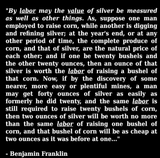>>17905146
Different commodities have different equilibrium prices, so that cannot be explained by supply and demand (post-production factors on the market) alone, but by factors inherent in the commodity's production, namely the labor time required for both the final commodity as well as the labor times required for the commodities contributing to the final commodity.
let us say commodity A has an equilibrium price of 3 dollars and commodity B has an equilibrium price of 5 dollars. In both cases, supply and demand are in equilibrium, so neither supply nor demand nor their interplay can explain in this case why commodity B is 2 dollars more expensive than commodity A. Since supply and demand represent factors outside of the commodity's production and they are in this case in equilibrium we have to look at factors within the commodity's production for an explanation. What immediately faces us is that commodities are assembled through labor processes, but they are also made out of other commodities which were themselves either assembled through labor processes, or, in the case of raw materials, gotten from the environment through labor processes. In all cases the average labor time required becomes essential to explaining prices differences, which Classical economists noted the post-classicals try to obfuscate or bury.
